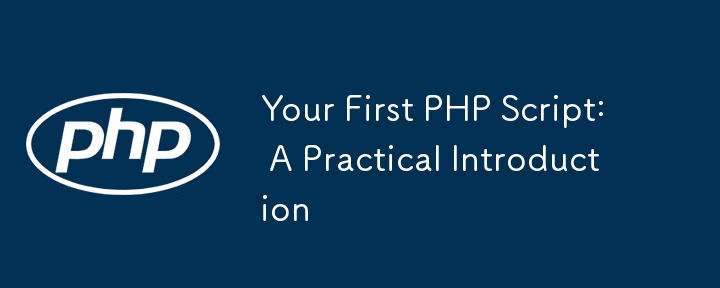Your First PHP Script: A Practical Introduction
How to start writing your first PHP script? First, set up the local development environment, install XAMPP/MAMP/LAMP, and use a text editor to understand the server's running principle. Secondly, create a file called hello.php, enter the basic code and run the test. Third, learn to use PHP and HTML to achieve dynamic content output. Finally, pay attention to common errors such as missing semicolons, citation issues, and file extension errors, and enable error reporting for debugging.

So you've decided to try writing your first PHP script — good choice. PHP might not be the newest language on the block, but it's still widely used, especially for web development. If you're aiming to build dynamic websites or interact with databases, PHP is a solid tool to have in your kit.

Let's cut to the challenge and walk through what you actually need to get started with your first working PHP script.
Setting Up Your Environment
Before you write any code, make sure your system is ready. PHP runs on a server, so unlike HTML or JavaScript, you can't just open a .php file in your browser and expect it to work.

Here's what you need:
- A local server environment : Tools like XAMPP (Windows/Mac), MAMP (Mac), or LAMP (Linux) let you run PHP locally without needing an actual web host.
- A text editor or IDE : VS Code, Sublime Text, or PHPStorm are popular choices.
- Basic understanding of how servers work : You'll place your PHP files in a specific folder
htdocslikehttp://localhost/your-file.php.
Once installed, test your setup by creating a simple PHP file and loading it in your browser.

Writing Your First Script
Now that your environment is ready, let's write something basic but useful. This script will display a message and show how PHP handles variables and basic logic.
Create a file called hello.php inside your server directory and add this:
<?php $name = "World"; echo "<h1>Hello, $name!</h1>"; ?>
Open your browser and go to http://localhost/hello.php . You should see “Hello, World!” in heading style.
What's happening here:
- The
<?php ... ?>tags tell the server to treat everything inside as PHP code. -
$nameis a variable holding the string"World". -
echooutputs HTML content back to the browser.
This may seem simple, but it demonstrates two key concepts: storing data and outputting it dynamically.
Mixing PHP with HTML
One of PHP's strengths is its ability to seamlessly mix with HTML. You don't have to choose between generating HTML or processing logic — you can do both in the same file.
Here's an example where PHP decides what message to show based on the time of day:
<!DOCTYPE html>
<html>
<head><title>Greeting</title></head>
<body>
<?php
$hour = date('G');
if ($hour < 12) {
echo "<p>Good morning!</p>";
} else {
echo "<p>Hello there!</p>";
}
?>
</body>
</html>This script does a few things:
- Uses
date()to get the current hour. - Checks if it's before noon and displays a different greeting accordingly.
- Outputs HTML from within PHP blocks.
You can switch back and forth between HTML and PHP as needed — just remember to close and reopen the PHP tags properly.
Common Pitfalls and Tips
Even small mistakes can break your script. Here are a few common issues beginners run into:
- Forgetting semicolons at the end of each PHP statement.
- Mixing up quotes and variables — double quotes allow variable interpolation; single quotes don't.
- Not checking error logs — when something doesn't work, look at your server's error log. It often tells you exactly what went wrong.
- Using incorrect file extensions — save files with
.php, not.html.
Also, enable error reporting during development by adding this line at the top of your script:
<?php ini_set('display_errors', 1); error_reporting(E_ALL); ?>
This helps catch mistakes early.
And that's basically it. With these basics down, you're ready to explore more powerful features like forms, databases, and user authentication. It's not complicated, but it does require attention to detail — especially around syntax and server behavior.
The above is the detailed content of Your First PHP Script: A Practical Introduction. For more information, please follow other related articles on the PHP Chinese website!

Hot AI Tools

Undress AI Tool
Undress images for free

Undresser.AI Undress
AI-powered app for creating realistic nude photos

AI Clothes Remover
Online AI tool for removing clothes from photos.

Clothoff.io
AI clothes remover

Video Face Swap
Swap faces in any video effortlessly with our completely free AI face swap tool!

Hot Article

Hot Tools

Notepad++7.3.1
Easy-to-use and free code editor

SublimeText3 Chinese version
Chinese version, very easy to use

Zend Studio 13.0.1
Powerful PHP integrated development environment

Dreamweaver CS6
Visual web development tools

SublimeText3 Mac version
God-level code editing software (SublimeText3)

Hot Topics
 Commenting Out Code in PHP
Jul 18, 2025 am 04:57 AM
Commenting Out Code in PHP
Jul 18, 2025 am 04:57 AM
There are three common methods for PHP comment code: 1. Use // or # to block one line of code, and it is recommended to use //; 2. Use /.../ to wrap code blocks with multiple lines, which cannot be nested but can be crossed; 3. Combination skills comments such as using /if(){}/ to control logic blocks, or to improve efficiency with editor shortcut keys, you should pay attention to closing symbols and avoid nesting when using them.
 Tips for Writing PHP Comments
Jul 18, 2025 am 04:51 AM
Tips for Writing PHP Comments
Jul 18, 2025 am 04:51 AM
The key to writing PHP comments is to clarify the purpose and specifications. Comments should explain "why" rather than "what was done", avoiding redundancy or too simplicity. 1. Use a unified format, such as docblock (/*/) for class and method descriptions to improve readability and tool compatibility; 2. Emphasize the reasons behind the logic, such as why JS jumps need to be output manually; 3. Add an overview description before complex code, describe the process in steps, and help understand the overall idea; 4. Use TODO and FIXME rationally to mark to-do items and problems to facilitate subsequent tracking and collaboration. Good annotations can reduce communication costs and improve code maintenance efficiency.
 Quick PHP Installation Tutorial
Jul 18, 2025 am 04:52 AM
Quick PHP Installation Tutorial
Jul 18, 2025 am 04:52 AM
ToinstallPHPquickly,useXAMPPonWindowsorHomebrewonmacOS.1.OnWindows,downloadandinstallXAMPP,selectcomponents,startApache,andplacefilesinhtdocs.2.Alternatively,manuallyinstallPHPfromphp.netandsetupaserverlikeApache.3.OnmacOS,installHomebrew,thenrun'bre
 Writing Effective PHP Comments
Jul 18, 2025 am 04:44 AM
Writing Effective PHP Comments
Jul 18, 2025 am 04:44 AM
Comments cannot be careless because they want to explain the reasons for the existence of the code rather than the functions, such as compatibility with old interfaces or third-party restrictions, otherwise people who read the code can only rely on guessing. The areas that must be commented include complex conditional judgments, special error handling logic, and temporary bypass restrictions. A more practical way to write comments is to select single-line comments or block comments based on the scene. Use document block comments to explain parameters and return values at the beginning of functions, classes, and files, and keep comments updated. For complex logic, you can add a line to the previous one to summarize the overall intention. At the same time, do not use comments to seal code, but use version control tools.
 Improving Readability with Comments
Jul 18, 2025 am 04:46 AM
Improving Readability with Comments
Jul 18, 2025 am 04:46 AM
The key to writing good comments is to explain "why" rather than just "what was done" to improve the readability of the code. 1. Comments should explain logical reasons, such as considerations behind value selection or processing; 2. Use paragraph annotations for complex logic to summarize the overall idea of functions or algorithms; 3. Regularly maintain comments to ensure consistency with the code, avoid misleading, and delete outdated content if necessary; 4. Synchronously check comments when reviewing the code, and record public logic through documents to reduce the burden of code comments.
 Learning PHP: A Beginner's Guide
Jul 18, 2025 am 04:54 AM
Learning PHP: A Beginner's Guide
Jul 18, 2025 am 04:54 AM
TolearnPHPeffectively,startbysettingupalocalserverenvironmentusingtoolslikeXAMPPandacodeeditorlikeVSCode.1)InstallXAMPPforApache,MySQL,andPHP.2)Useacodeeditorforsyntaxsupport.3)TestyoursetupwithasimplePHPfile.Next,learnPHPbasicsincludingvariables,ech
 Mastering PHP Block Comments
Jul 18, 2025 am 04:35 AM
Mastering PHP Block Comments
Jul 18, 2025 am 04:35 AM
PHPblockcommentsareusefulforwritingmulti-lineexplanations,temporarilydisablingcode,andgeneratingdocumentation.Theyshouldnotbenestedorleftunclosed.BlockcommentshelpindocumentingfunctionswithPHPDoc,whichtoolslikePhpStormuseforauto-completionanderrorche
 PHP Development Environment Setup
Jul 18, 2025 am 04:55 AM
PHP Development Environment Setup
Jul 18, 2025 am 04:55 AM
The first step is to select the integrated environment package XAMPP or MAMP to build a local server; the second step is to select the appropriate PHP version according to the project needs and configure multiple version switching; the third step is to select VSCode or PhpStorm as the editor and debug with Xdebug; in addition, you need to install Composer, PHP_CodeSniffer, PHPUnit and other tools to assist in development.







